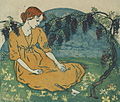Marija Wassiljewna Jakuntschikowa

Marija Wassiljewna Jakuntschikowa ( Russian Мария Васильевна Якунчикова ; born January 19, 1870 in Wiesbaden , † December 27, 1902 in Chêne-Bougeries ) was a Russian artist .
Life
Jakuntschikowas parents were the Moscow entrepreneur Vasily Ivanovich Jakuntschikow and his second wife Sinaida Nikolajewna née Mamontowa (1843-1919, cousin Savva Ivanovich Mamontov and sister of the wife of the merchant Pavel Mikhailovich Tretyakov ), who were recovering at the time of their birth in Wiesbaden. Yakuntschikova was already enthusiastic about drawing as a child , so her father hired the graphic artist and watercolorist Nikolai Avenirovich Martynov to teach the children . In 1885, after her sister Natalja, who married Vasily Dmitrijewitsch Polenow, she entered the Moscow School of Painting, Sculpture and Architecture as a guest student . Soon they took the Polenow characters evenings Vasily Dmitrievich Polenows and his sister Yelena Polenova part in their house, including Valentin Serov , Isaac Ilich Levitan , Ilya Semyonovich Ostroukhov , Mikhail Vrubel , Victor and Apollinary Vasnetsov , Mikhail Nesterov and Konstantin and Sergei Alexejewitsch Korovin came. During this time Jakuntschikowa studies made on Russian history in time Alexei I. on.
At first, Jakuntschikowa devoted himself to landscape painting and the representation of nature. In the summer of 1888, in Schukowka, where the Polenows lived, the study Das Boot auf der Kljasma was created . In the fall of 1888 she traveled with her family in Western Europe . Her youngest sister Jelena (1882–1888) died in Italy during the trip . In the winter of 1888, doctors diagnosed Yakuntschikova with tuberculosis and recommended climate change. She decided not to continue studying in Moscow and went to Vienna , Italy and Biarritz for treatment . In the summer of 1889 she returned to Moscow and in the autumn traveled with the family to the Paris World Exhibition of 1889 . There she studied at the Académie Julian with William Adolphe Bouguereau and Tony Robert-Fleury . She spent the summers in Russia . She worked on her father's estate in Vvedenskoye near Zvenigorod , where she loved the manor house , and Cheryomushki-Znamenskoye on the outskirts of Moscow and in Abramzewo . Her mural The Silence is there at the entrance to the museum.
In 1894, Yakuntschikowa left the Académie Julian. She rented a studio in Paris and began to work independently. She exhibited her work in the Salon de Paris . She devoted herself to decorative arts , wooden toys , pyrography , embroidery and picture knitting . She also combined pyrography with oil painting . Like her closest friend Jelena Dmitrijewna Polenowa, she was enthusiastic about folk art and collected it. Folk neo-Russian motifs appear in her mural The Town (1896).
In 1896, Yakuntschikowa married the Russian student Léon Weber-Bauler (1870-1956), who studied medicine at the University of Paris . In 1898 they had their son Stepan.
During these years Jakuntschikowa's masterpieces were created. In addition to paintings , she also created majolica and graphics , which influenced the graphic artist Anna Petrovna Ostroumowa-Lebedewa . Members of the Mir Iskusstwa invited Yakuntschikova to their exhibitions. For the World Exhibition in Paris in 1900 , Yakuntschikova contributed to the design of the handicraft department of the Russian pavilion with his own large works of art.
In 1900, Yakuntschikova's son Stepan was diagnosed with tuberculosis, which could be cured. She was diagnosed with tuberculosis again. In 1901 the second son was born. The family moved to Chamonix and then to Chêne-Bougeries, where Weber-Bauler had bought a house.
After Yakunchikova's death, the editor-in-chief of Mir Iskusstva's magazine, Sergei Pavlovich Dyagilev, published an obituary in the magazine. Yakuntchikova's works were exhibited at the second exhibition of the Union of Russian Artists. In 1910 a Yakuntschikowa exhibition took place in the Musée Rath in Geneva . Works by the artist are in the Tretyakov Gallery in Moscow, the Russian Museum in St. Petersburg and the Polenov Manor House Museum in Saoksky Raion . A significant part of her works is in the private collections of the descendants of the Weber-Bauler family and in the artist's house in Chêne-Bougeries.
Works
Web links
Individual evidence
- ↑ a b Филаткина Н. А .: Якунчиковы . In: Энциклопедический справочни . 1992 ( [1] accessed January 12, 2018).
- ↑ a b Михаил Киселев: Мария Якунчикова и русский модерн (accessed January 13, 2018).
- ↑ Михаил Киселев: Мария Якунчикова . Mir Iskusstwo, Moscow 2005, ISBN 5-85200-416-2 .
- ↑ a b c d e Maria Yakunchikova-Weber (1870–1902): Life between Russia and Switzerland (accessed on January 13, 2018).
- ↑ a b c d Мария ЯКУНЧИКОВА - Maria YAKUNCHIKOVA (accessed January 13, 2018).
- ^ Leon Weber-Bauler, 1870-1956 . In: Rev. Med. Suisse Romande . tape 76 , no. 7 , 1956, pp. 813-816 .
- ↑ Кошелева В. Л .: Елена и Мария . In: Московский журнал . No. 3 , 2010, p. 20 .
| personal data | |
|---|---|
| SURNAME | Jakuntschikowa, Marija Wassiljewna |
| ALTERNATIVE NAMES | Якунчикова, Мария Васильевна (Russian) |
| BRIEF DESCRIPTION | Russian artist |
| DATE OF BIRTH | January 19, 1870 |
| PLACE OF BIRTH | Wiesbaden |
| DATE OF DEATH | December 27, 1902 |
| Place of death | Chêne-Bougeries |









